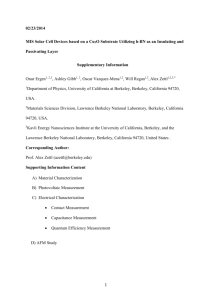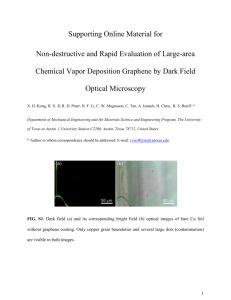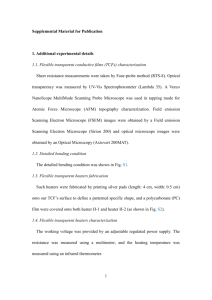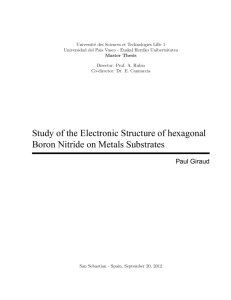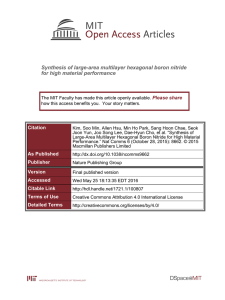Proposal 4 - University of Oregon
advertisement
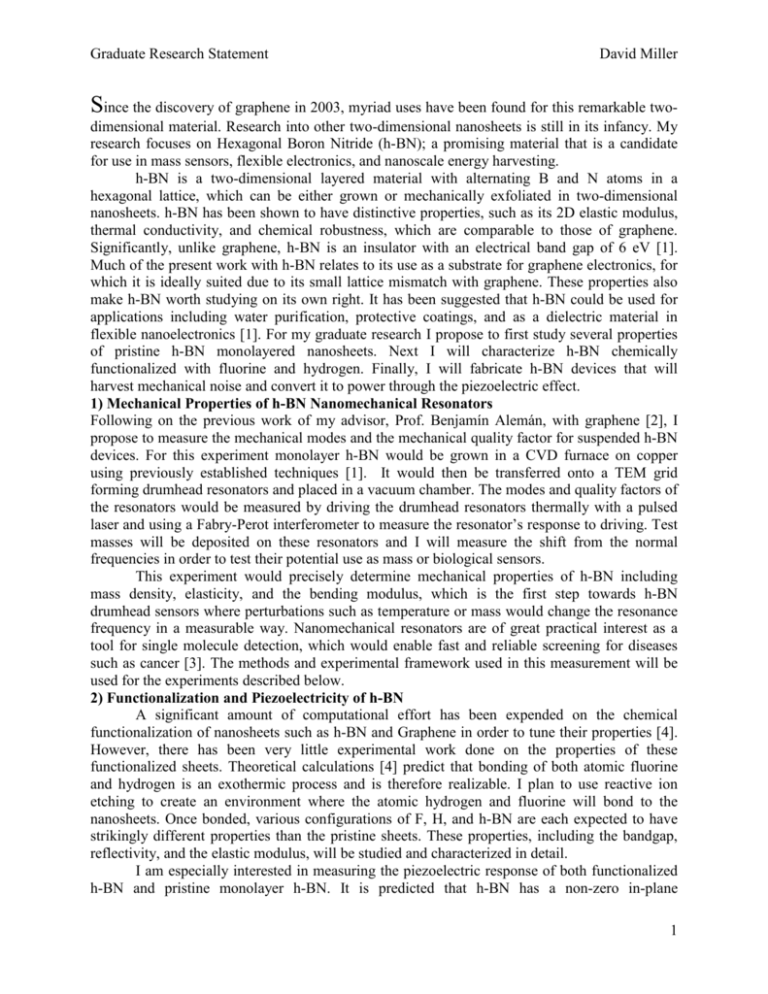
Graduate Research Statement David Miller Since the discovery of graphene in 2003, myriad uses have been found for this remarkable twodimensional material. Research into other two-dimensional nanosheets is still in its infancy. My research focuses on Hexagonal Boron Nitride (h-BN); a promising material that is a candidate for use in mass sensors, flexible electronics, and nanoscale energy harvesting. h-BN is a two-dimensional layered material with alternating B and N atoms in a hexagonal lattice, which can be either grown or mechanically exfoliated in two-dimensional nanosheets. h-BN has been shown to have distinctive properties, such as its 2D elastic modulus, thermal conductivity, and chemical robustness, which are comparable to those of graphene. Significantly, unlike graphene, h-BN is an insulator with an electrical band gap of 6 eV [1]. Much of the present work with h-BN relates to its use as a substrate for graphene electronics, for which it is ideally suited due to its small lattice mismatch with graphene. These properties also make h-BN worth studying on its own right. It has been suggested that h-BN could be used for applications including water purification, protective coatings, and as a dielectric material in flexible nanoelectronics [1]. For my graduate research I propose to first study several properties of pristine h-BN monolayered nanosheets. Next I will characterize h-BN chemically functionalized with fluorine and hydrogen. Finally, I will fabricate h-BN devices that will harvest mechanical noise and convert it to power through the piezoelectric effect. 1) Mechanical Properties of h-BN Nanomechanical Resonators Following on the previous work of my advisor, Prof. Benjamín Alemán, with graphene [2], I propose to measure the mechanical modes and the mechanical quality factor for suspended h-BN devices. For this experiment monolayer h-BN would be grown in a CVD furnace on copper using previously established techniques [1]. It would then be transferred onto a TEM grid forming drumhead resonators and placed in a vacuum chamber. The modes and quality factors of the resonators would be measured by driving the drumhead resonators thermally with a pulsed laser and using a Fabry-Perot interferometer to measure the resonator’s response to driving. Test masses will be deposited on these resonators and I will measure the shift from the normal frequencies in order to test their potential use as mass or biological sensors. This experiment would precisely determine mechanical properties of h-BN including mass density, elasticity, and the bending modulus, which is the first step towards h-BN drumhead sensors where perturbations such as temperature or mass would change the resonance frequency in a measurable way. Nanomechanical resonators are of great practical interest as a tool for single molecule detection, which would enable fast and reliable screening for diseases such as cancer [3]. The methods and experimental framework used in this measurement will be used for the experiments described below. 2) Functionalization and Piezoelectricity of h-BN A significant amount of computational effort has been expended on the chemical functionalization of nanosheets such as h-BN and Graphene in order to tune their properties [4]. However, there has been very little experimental work done on the properties of these functionalized sheets. Theoretical calculations [4] predict that bonding of both atomic fluorine and hydrogen is an exothermic process and is therefore realizable. I plan to use reactive ion etching to create an environment where the atomic hydrogen and fluorine will bond to the nanosheets. Once bonded, various configurations of F, H, and h-BN are each expected to have strikingly different properties than the pristine sheets. These properties, including the bandgap, reflectivity, and the elastic modulus, will be studied and characterized in detail. I am especially interested in measuring the piezoelectric response of both functionalized h-BN and pristine monolayer h-BN. It is predicted that h-BN has a non-zero in-plane 1 Graduate Research Statement David Miller piezoelectric response. Intriguingly, simulations show that h-BN functionalized either in the HBN-H or F-BN-F configuration will exhibit broken symmetry and will show a strong out of plane piezoelectric response [4]. That is to say, an applied stress in the z-plane will produce a voltage across electrodes placed in the x- or y-plane. Out-of-plane piezoelectricity has not been demonstrated in any 2-dimensional material to this point. Piezoelectric, atomically thin membranes offer exciting applications as both sensors and actuators at the nanoscale, which is of great importance as nanomechanical devices continue to be miniaturized. 3) Piezoelectric Energy Harvesting Using h-BN Nanosheets Another highly promising application of two-dimensional piezoelectrics is as nanoscale energy harvesters. Is has been calculated that a suspended 20 nm2 h-BN device could harvest 0.18 pW from characteristic ambient vibrational noise intensity of 5 pN, a number comparable to the ambient thermal noise at room temperature of 1 pN [5]. Such a device could be created by suspending an h-BN monolayer between two electrodes and allowing a stress such as vibrational noise to induce a potential across the layer. These energy harvesters open the possibility for selfpowered devices such as sensors and computers at the nanoscale. In-plane piezoelectricity and mechanical to electrical power conversion in Molybdenum Disulfide (MoS2) has recently been demonstrated and the techniques used can be replicated for h-BN [6]. Novel methods will have to be developed for the measurement of the out-of-plane piezoelectric response. I am well-situated at the University of Oregon (UO) to do the suggested research. Professor Alemán is extremely well-versed in graphene research and his knowledge can be directly applied to h-BN. We will also collaborate with Professor Alex Zettl’s group at UC Berkeley and make use of their expertise in the growth of h-BN nanostructures. Our lab is currently in the process of integrating a chemical vapor deposition (CVD) furnace for growth and possesses all the necessary equipment to perform the proposed measurements. Additionally, UO hosts a world-class nanofabrication and microanalytical facility, the Center for Advanced Materials Characterization in ORegon (CAMCOR). It is thus possible to do most of the materials fabrication and characterization in-house. Over the course of my first year in graduate school, I have independently built and characterized the Fabry-Perot resonator that will be used for many of the measurements on the h-BN nanosheets. In doing so, I have established the techniques that will be used to acquire and analyze data from several of the proposed experiments. Receiving this NSF fellowship would allow me the freedom to successfully complete these projects, which would both increase our understanding of h-BN and open the doors for development of future nanomechanical systems such as biological sensors, energy harvesters, and actuators. It would also be fruitful for my own personal development and my goal of one day commercializing technologies we create in the laboratory with the goal of addressing problems in both the first world and the developing world. [1]Roland Yingjie Tay, et al. (2014). “Growth of Large Single-Crystalline Two-Dimensional Boron Nitride Hexagons on Electropolished Copper.” Nano Letters 14 (2), 839-846 [2]Alemán, B., et al. (2013). “Polymer-free, low tension graphene mechanical resonators.” Phys. Status Solidi RRL, 7: 1064–1066. [3]Kilho Eom, et al. (2011). “Nanomechanical resonators and their applications in biological/chemical detection: Nanomechanics principles”, Physics Reports, Volume 503, Issues 4–5, Pages 115-163. [4]M. Noor-A-Alam, et al. (2014). “Dipolar polarization and piezoelectricity of a hexagonal boron nitride sheet decorated with hydrogen and fluorine.” Phys. Chem. Chem. Phys. 16, 6575. [5]M. Lopez-Suarez, et al. (2014) “Piezoelectric monolayers as nonlinear energy harvesters.” Nanotechnology 25, 175401 (175405 pp.)-175401 (175405 pp.) [6]Wenzhuo Wu, et al. (2014) “Piezoelectricity of single-atomic-layer MoS2 for energy conversion and piezotronics”. Nature 514, 470–474 2
